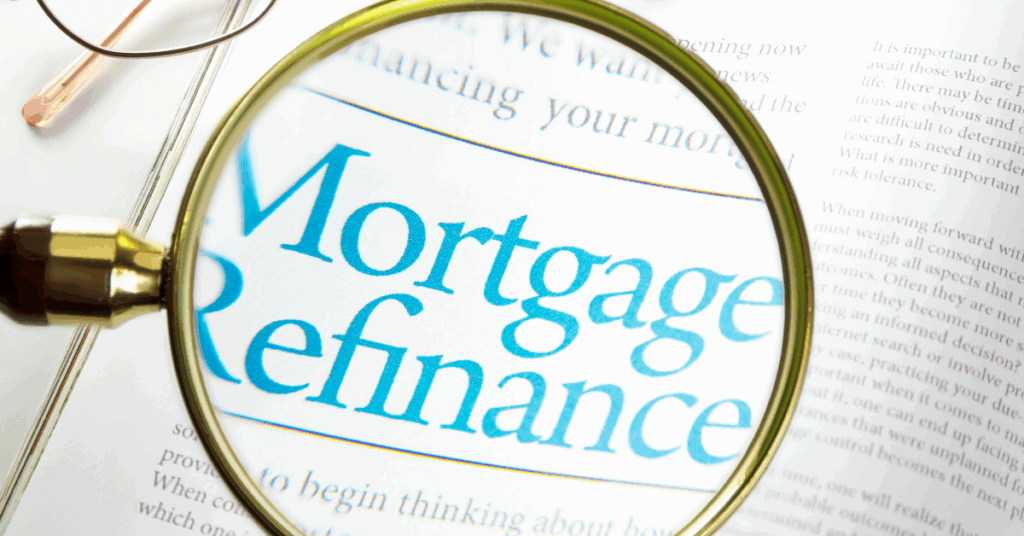Get Expert Financing
- Matched with investor-friendly lenders
- Fast pre-approvals-no W2s required
- Financing options fro rentals, BRRRR, STRs
- Scale your portfolio with confidence
There are many benefits of refinancing your home, ranging from a lower monthly payment to the opportunity to consolidate debt.
If you have any interest in this process, it’s critical to know exactly what you’re getting into. This helps reduce the risk of a costly and time-consuming mistake
Let’s take a look at the steps to refinancing your home, so that you can be the most equipped once you decide to do so.
Mortgage refinancing is the act of replacing your current mortgage with a new loan.
You can do this to secure a lower interest rate, a lower monthly payment, to access equity, or to reduce your term (as to pay off your home sooner).
The question of whether or not you should refinance your mortgage depends on your financial circumstances, short and long-term financial goals, and willingness to move through the process.
For example, if your current mortgage payment is more than you can afford, refinancing at a lower rate and a longer term may be just what you need.
Tip: Don’t refinance your home unless you know that you’ll make out financially in the long run. A mortgage calculator allows you to crunch the numbers and review multiple scenarios based on your inputs.
Submit Your Loan ScenarioOnce you’re on board with the idea of refinancing your mortgage, it’s time to take action. The following are six steps to refinancing your home.
A strong credit history and excellent credit score increases your odds of receiving a loan approval.
Also, the higher your score, generally, the lower your interest rate — and this can save you thousands of dollars over the life of your loan.
According to Experian, an excellent credit score is anywhere from 800 to 850. This is followed by very good (740-799), good (670-739), fair (580-669), and poor (300-579).
If your credit score has room for improvement — meaning that it’s not yet in the excellent range — you may want to take some time to improve it first.
You can do so by reviewing your credit report for errors, paying down balances, and making sure that all future payments are made in full and on time.
This goes along with deciding if it makes sense to refinance your mortgage. Refinancing is only something to consider if you know your goals and have a clear vision of how to reach them.
Some of the most common goals associated with mortgage refinancing include:
Some of these goals standalone, while others can be combined.
For instance, if you want to shorten your payoff period, it’s likely to result in a higher monthly payment.
However, if your goal is to lower your monthly payment, you’re often able to do so by qualifying for a lower interest rate.
With the right goals, there’s a reduced chance of your refinance ending in disappointment.
Once you decide to refinance, it’s easy to find yourself in a hurry.
You want to take immediate action so that you can close on your loan sooner rather than later. While a sense of urgency is a good thing, it can also force you into making a poor decision that you’ll regret.
There are many benefits of taking a few extra minutes (or hours) to shop around for the best loan:
As a general rule of thumb, it’s most time-efficient to shop for a refinance loan online.
An online service — such as My Perfect Mortgage — allows you to quickly compare lenders and loans so you can make an informed and confident choice.
Every lender has a different way of dealing with closing costs and fees.
It’s likely that you’ll find that some lenders charge fees that others don’t. And that’s why you need to compare lenders, with some of your time focused on closing costs and fees.
Common fees associated with a mortgage refinance include:
If all else is equal, choose the lender with the lowest fees. This will speed up the amount of time that it takes to break even.
Tip: It’s unfortunate, but some lenders will attempt to sneak fees into your loan shortly before closing. They assume that you won’t turn back because of how close you are to the end of the line. Don’t fall for this. If your lender doesn’t stand by their loan disclosure — which estimates your closing costs — stop where you are and reconsider.
While it’s not something you have to schedule yourself, it is a big part of refinancing your mortgage. You’ll work with your lender and appraiser to find a time that works for them to visit your home.
This gives the appraiser the opportunity to inspect your home inside and out to provide the lender with an accurate value. Your lender needs this information before giving you final approval to close on your loan.
Take, for example, a home that is assessed at less than what the homeowner wants to borrow. In this case, the application will be denied as it’s too much of a risk for the lender.
As a homeowner, the appraised value is especially important if you plan on accessing the equity in your property. You may decide to do so to tackle expenses, such as an upcoming home renovation, or to consolidate debt.
You can only do so much to prepare your home for an appraisal, but it doesn’t hurt to clean it inside and out or make any small improvements you know are needed. No, an appraiser isn’t looking at how you organize your home, but a positive appearance doesn’t hurt.
Since you’re staying in your home, there are no keys exchanged at closing.
See What You Qualify ForHowever, that doesn’t make this step to refinancing your home any less important. This is the end of the process. As long as everything goes as planned, you’re only 30 to 60 minutes away from moving forward toward your new financial goals.
The first thing you must do is prepare for closing day, which means reviewing your closing disclosure.
The Consumer Financial Protection Bureau defines “closing disclosure” as:
“A Closing Disclosure is a five-page form that provides final details about the mortgage loan you have selected. It includes the loan terms, your projected monthly payments, and how much you will pay in fees and other costs to get your mortgage (closing costs).”
Your lender is required to provide you with this disclosure at least three business days before your scheduled closing. Use this time to review the numbers, request any necessary changes, and ask questions.
Now, let’s move onto a few important aspects regarding the day of your closing:
No matter who you are, when you take these steps to refinancing your home, your goal is the same — to close on a loan that suits the goals you’ve set.
At every step in the process, there are numbers that will dictate your next move.
Don’t rush the process. Take your time, compare several lenders and loan options, and compare the numbers in front of you.
This includes but is not limited to:
You can spend hours on end conducting research, but there will still come a point when you have questions about refinancing your mortgage. Some of these you can answer on your own, while others require the guidance of your lender.
The following are some of the most frequently asked questions.
Every lender has its own standards, but there are three things that always come into play: low debt-to-income ratio, good credit score, and home equity.
Some of the options to discuss with your lender include cash-out refinance, cash-in refinance, rate and term refinance, VA streamline refinance, FHA streamline refinance, and USDA streamline refinance.
A cash-out refinance allows you to take on a higher loan balance in exchange for cash. The amount of cash you can access depends on the value of your home and current balance.
You can use the cash however you see fit, with examples including debt consolidation, home improvements, and educational expenses.
It’s very rare for a lender to allow a borrower to cash out 100 percent of their home equity. In most cases, you’re required to leave a minimum of 20 percent equity in your property. Talk to your lender about this upfront if you’re most interested in a cash-out refinance.
You don’t want to get to the end of the process just to find that you’re surprised at the closing costs. Ask your lender for an estimate upfront, as this will help you decide if you want to proceed.
Within three business days of your scheduled closing, you’ll receive a closing disclosure. This document outlines your closing costs down to every last detail. Expect closing costs between two and five percent of the value of your loan.
Start your loan applicationThis can be a big deal to some people. If you’re refinancing because you’re dissatisfied with your current lender, you want to know that your new lender won’t sell your loan.
You want to know how this could change any services of your loan. If possible, choose a lender that will service your loan in-house. This will give you peace of mind.
Refinance interest rates can and do change by the day. If you don’t lock in your low rate today, it may not be available tomorrow, next week, or next month.
Even though closing a refinance loan is quicker than a first loan, it’ll still take 30+ days. A rate lock allows you to lock in your rate through your closing day. This way, as long as everything goes as planned with your timeline, you’re protected against an increase.
According to Freddie Mac, in 2021, borrowers saved an average of $2,800 annually in mortgage payments by refinancing. This was due in large part to historically low interest rates.
If you’re ready to get started, the team at My Perfect Mortgage is here to assist you the steps to refinancing your home.
We’ll quickly connect you with a lender that matches your financial situation. From there, you can gather more information and make a final decision on whether you should take the steps to refinance.
Photo by RODNAE Productions from Pexels
Our advice is based on experience in the mortgage industry and we are dedicated to helping you achieve your goal of owning a home. We may receive compensation from partner banks when you view mortgage rates listed on our website.


